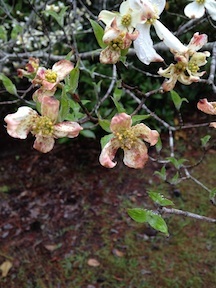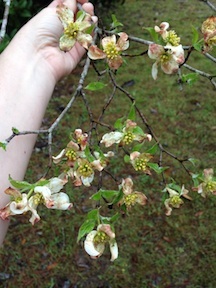 Spot anthracnose is caused by Elsinoe corni and should not be confused with an Discula anthracnose. It affects the flower bracts (petals), leaves and young shoots. The most conspicuous symptoms are small (1/25 to 1/16 inch in diameter), circular to elongate reddish-purple spots on the bracts in early spring. The spots may become numerous and merge, losing the distinctive characteristics of individual spots. Severely infected bracts may be stunted and disfigured and fall prematurely.
Spot anthracnose is caused by Elsinoe corni and should not be confused with an Discula anthracnose. It affects the flower bracts (petals), leaves and young shoots. The most conspicuous symptoms are small (1/25 to 1/16 inch in diameter), circular to elongate reddish-purple spots on the bracts in early spring. The spots may become numerous and merge, losing the distinctive characteristics of individual spots. Severely infected bracts may be stunted and disfigured and fall prematurely.
 Spots on leaves are very small and dark purple in color, but the centers may turn pale yellow-gray and drop out. Heavily infected leaves are smaller than normal, distorted and often killed. Infected young shoots and berries develop elongated, scabby lesions with a purplish margin. The causal fungus produces spores on the lesions, and overwinters on infected twigs and fruit. Fungicide sprays can reduce the problem but because susceptibility is linked to environment and the genetics of the tree (some varieties and seedlings are very susceptible to the disease while others are very resistant) complete control is sometimes impossible. This disease will not kill the tree. The best course of action is to plant trees that are resistant to this disease.
Spots on leaves are very small and dark purple in color, but the centers may turn pale yellow-gray and drop out. Heavily infected leaves are smaller than normal, distorted and often killed. Infected young shoots and berries develop elongated, scabby lesions with a purplish margin. The causal fungus produces spores on the lesions, and overwinters on infected twigs and fruit. Fungicide sprays can reduce the problem but because susceptibility is linked to environment and the genetics of the tree (some varieties and seedlings are very susceptible to the disease while others are very resistant) complete control is sometimes impossible. This disease will not kill the tree. The best course of action is to plant trees that are resistant to this disease.
